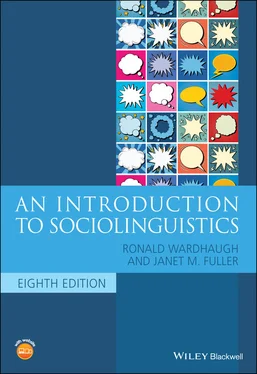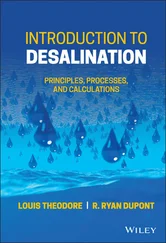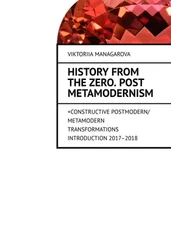Research within this paradigm can provide insights into implicit biases which research participants are unlikely to admit to, or even be aware of. For example, Pantos and Perkins (2013) did a task which showed that native speakers of English were aligned with ‘good’ while speakers of English with a foreign accent were aligned with ‘bad,’ although the research participants reported no bias when asked about their attitudes.
Other associations were also measured by Campbell‐Kibler (2012) in research among US university students. This research showed associations between a particular variable and social factors. One variable examined was ING, that is, the variation in realization of the ‐ ing ending on English words as (for example) being versus bein’ . The results showed that the ‐ ing form was associated with Northern states, white‐collar professions, and network news anchors, while the ‐ in’ variable was associated with Southern states, blue‐collar professions, and country singers. Further experiments also showed that this task could also examine associations between different linguistic variants. For example, the ‐ in’ variant was also associated with /ai/ monophthongization, a stereotypical Southern dialect feature. (As we will discuss further in chapter 5, the ING variable is one which has been studied extensively.) Thus this task is promising for not just studying language attitudes, but sociolinguistic meaning of linguistic features more generally.
Given the clear patterns of attitudes in many of these studies, we must consider the consequences of such evaluative reactions to certain ways of speaking. While this topic has not been the focus of attitudes studies to date, a 2019 special issue in the Journal of Language and Discrimination centers on this theme (see Baumgartner and Du Bois 2019, in Further Reading). We will continue to address this issue in this text, with special focus on discrimination and social justice in Part IV.
In this chapter, we have grappled with how to define the social groups whose language we wish to describe and study in sociolinguistic research, noting that some of the same difficulties in defining a language surface in defining what a speech community might be. There is a tendency to look beyond the ways that people speak to define what makes them a community, and to focus on the presence of shared norms. Alternative ways of defining groups, for example, as a community of practice or a social network, are also presented as less abstract means of determining a social group for the purpose of research; both depend on linguistic interaction for their definitions. We also revisit the concept of identities, presenting a framework for the study of language and identity. Finally, we address language ideologies and attitudes, noting that these beliefs about linguistic varieties and their users influence how we use language as well as the everyday lives of those whose language we judge.
1 Make a short (15–30 minutes) audio recording of a community of practice you participate in (be sure you have the permission of everyone in the group before you record!). This could be your roommates or family members you live with, some friends you often eat lunch with, a group of co‐workers, members of a knitting group, your rugby teammates, and so on; the only criteria is that this must be a group that meets and interacts regularly. Listen to the recording and answer the following questions:How can you describe the joint endeavor of this group? Do there seem to be common goals of the interaction?In what ways are the varieties spoken by the individuals in the group different – that is, do they come from different areas or social groups and have linguistic features that are associated with different varieties? Is there ever explicit mention made of speech differences?In what ways do you see the shared norms of the group – are there particular lexical items or nicknames that are used in this group? Inside jokes? Topics of conversation that recur? In short, try to ascertain what features of the conversation indicate that this is a group that interacts frequently and not a group of strangers.
2 Find a map of the country you live in which has major state or province boundaries but no labels for these regions, and ask ten people to draw dialect boundaries on the map, name the dialects, and rate them on scales of 1–10 in terms of correctness and pleasantness. Be sure to record relevant information about each of these research participants – for instance, age, sex category identification, nationality, race/ethnicity, socioeconomic class identification, occupation, location of residence, region of origin. Answer the following questions about your data:Are similar dialect regions identified by all or most of the research participants? Provide an overview of these regions.Are there accepted names for different dialects? If so, can you explain how this has come to be the case – are they discussed in popular media, or in school? If not, how can you explain the absence of terms for regional dialects?How are different regional dialects evaluated in terms of their correctness and pleasantness?How can you account for variation in your data? That is, do particular traits of the research participants (e.g., where they are from) seem to influence how they feel about particular dialects?
3 Find a YouTube video that is related to how a particular social group uses language – this may be intentionally about the language (e.g., a ‘tutorial’ or description of a particular dialect, a satire about how a certain group uses language) or a video in which users of a particular variety are talking about something else, but the comments and distribution of the video focus on the way they talk. What language ideologies are represented in this video? Do they represent ideologies that you, with your budding knowledge of sociolinguistics, would like to challenge?
1 Baumgartner, Nicole and Inke Du Bois (eds.) (2019). Special issue: Linguistic discrimination and cultural diversity in social spaces. Journal of Language and Discrimination 3(2).
2 Gal, Susan and Judith Irvine (1995). The boundaries of languages and disciplines: How ideologies construct difference. Social Research 62: 996–1001.
3 Long, Daniel and Dennis Preston (2002). The Handbook of Perceptual Dialectology, vol. 2. Amsterdam: John Benjamins.
4 Meyerhoff, Miriam and Anna Strycharz (2013). Communities of practice. In Jack K. Chambers and Natalie Schilling (eds.), The Handbook of Language Variation and Change. 2nd edn. Oxford: Wiley Blackwell, 428–447.
5 Milroy, Lesley and Carmen Llamas (2013). Social networks. In Jack K. Chambers and Natalie Schilling (eds.), The Handbook of Language Variation and Change. 2nd edn. Oxford: Wiley Blackwell, 409–427.
6 Preston, Dennis (1999). The Handbook of Perceptual Dialectology, vol. 1. Amsterdam: John Benjamins.
7 Tagg, C. and P. Seargeant (2016). Facebook and the discursive construction of the social network. In Alexandra Georgakopoulou and Tereza Spilioti (eds.), The Routledge Handbook of Language and Digital Communication. London: Routledge, 339–353.
1 Aitchison, J. and D. Lewis (eds.) (2003). New Media Language. London: Routledge.
2 Akkaya, A. (2014). Language, discourse and new media: A linguistic anthropological perspective. Language and Linguistic Compass 8(7): 285–300.
3 Albury, N. J. and L. Carter (2018). ‘An unrealistic expectation’: Māori youth on indigenous language purism. International Journal of the Sociology of Language 254: 121–138.
4 Alfaraz, G. (2002). Miami Cuban perceptions of varieties of Spanish. In Daniel Long and Dennis R. Preston (eds.), Handbook of Perceptual Dialectology, vol. 2. Amsterdam: John Benjamins, 1–11.
Читать дальше




![Andrew Radford - Linguistics An Introduction [Second Edition]](/books/397851/andrew-radford-linguistics-an-introduction-second-thumb.webp)







